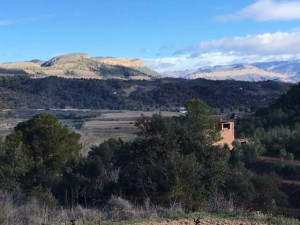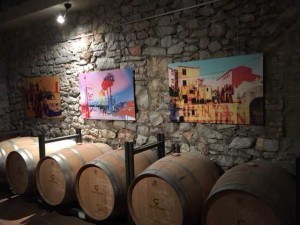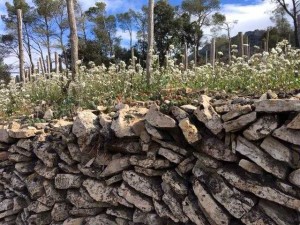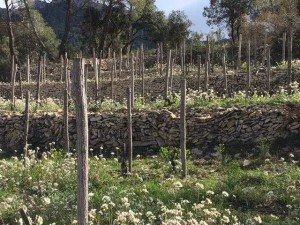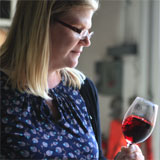Today we have a post from guest blogger Kryss Speegle. Kryss tells us about a recent trip to the Montstant DO. Read on for some insight into the history, the wines, and the region…but be warned this article is going to make you want to run and book a ticket to Spain!
Marta Carbonell of Josep Grau Viticultor speaks with a quiet and engaging matter-of-factness: “We like high acidity. We love fruit. We hate oak.” Speaking for her own wines, she could easily be describing the Montsant style, and after a three-day visit, sponsored by Wines of Montsant, I’m ready to make this my mantra as well.
Unlike its flashy neighbor Priorat, where the famous llicorella slate dominates the landscape, Montsant is a patchwork of limestone, chalk and sand as well as slate, and elevations ranging from 50 to 700 meters; the wines are fresh and powerful with ferrous minerality and a core of intense fruit.
Wine has been a significant product of Catalonia since at least the 6th to 8th centuries BCE, though vine plantings increased significantly after the establishment of the monastery of Poblet. Italian and Middle Eastern varieties were eventually replaced by primarily with Carinyena (Carignan, also known by its Catalan name Samsó) and Garnatxa (Grenache); a treasury of old vines remains today and red grapes account for 95% of production. Though Garnatxa has slightly higher production, Carinyena is also a star player alone or in blends and a firm rebuke to those who view it primarily as a high-yielding blender. The 100% Carinenya from Cellers Sant Rafel is fresh and even elegant. The minute plantings of white grapes are mostly Garnatxa Blanca and Macabeo, which make wines with a perfumed lift and flavors of baked apple, lemon curd and hawthorn.
Cabernet Sauvignon, Merlot and Syrah exist in small plantings but are silent partners at best. A happy exception to this is the use of Syrah for rosé wines; in a single sitting, two lovely examples, one from Coca i Fito (fresh and restrained) and another from Celler Rondanelles (intensely fruity) remind me that rosé complements grilled octopus, braised artichokes, potato chips and just about everything else.
Previously dominated by workhorse co-operatives, Montsant became a Denominación de Origin (DO) distinct from Tarragona in 2001 and within three years had 26 members across its 1,800 hectares, a testament to producers’ commitment to the region. Some are Priorat vintners looking for a bargain while others are locals who bucked the historical exodus to Barcelona. It’s an uplifting narrative for anyone accustomed to hearing that the world’s great wine regions are all supersaturated with vines or prohibitively expensive.
As the driver in front of us repeatedly stops to point at various vines, our guide from the DO claims that nearly everyone in the area has a few inherited plots — “Once poor farmers, now proud viticulturalists.” The region is also home to a thriving polyculture; marcona almonds, hazelnuts, cherries, and peaches are commercially grown and the slopes are dotted with wildflowers and resinous herbs.
Co-ops are still in the game but, as elsewhere in Europe, are redefining the old label with exciting and pleasurable wines. At Celler de Capçanes, a traditional co-operative found a successful niche in kosher wine production; the Peraj Ha’abib is the mainstay of this line and is lovely. The real excitement, though, is their “La Nit de les garnatxes” collection exploring the diversity of Montsant’s terroirs. Four wines of 100% Garnatxa, each representing one of the region’s four soil types, are presented in some of the cleverest packaging I’ve seen yet, wrapped in color-coded comics explaining the soil’s effect on the wine. The wines themselves do an amazing job telling the story of Montsant by drawing out its shades of difference—by turns refined and sinewy, generously fruited and earthy.
Nearly half of Montsant’s wines are exported with many available in U.S. retailers. For those who want a closer look, the DO’s commercial center is Falset, a self-sufficient town of 2,800 and a good base for exploring. To discover from a distance, see these sites:
- www.domontsant.com/en
- https://www.nytimes.com/2016/11/28/dining/wine-school-montsant.html
- http://www.decanter.com/wine-news/opinion/jefford-on-monday/montsant-wines-profile-spain-381352/
- https://www.wine-searcher.com/regions-montsant
About the Author: Kryss Speegle works in bulk sales, supplying wines and spirits to customers throughout the United States and around the world. Previously she was O’Neill’s Director of Winemaking, where she managed the company’s extensive varietal wine programs and led a talented team of winemakers.
Prior to O’Neill, Kryss held winemaking and enologist roles at Kenwood and Ravenswood. She has also worked for wineries in Napa, Mendocino, Germany and New Zealand. Kryss has served as a past judge for the San Francisco Chronicle and West Coast wine competitions and has taught wine courses at Santa Rosa Junior College and Napa Valley Wine Academy.
Kryss received a Bachelor’s degree from University of Virginia and a graduate degree in Food Science/Enology from University of California at Davis. While at Davis, Kryss conducted sensory research for Dr. Ann Noble, creator of the Wine Aroma Wheel.
When she’s not in the vineyard or in the production facility, Kryss enjoys cooking, traveling and spending time with her family.
Photo credits: Kryss Speegle
